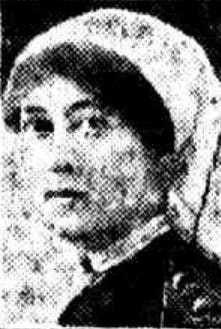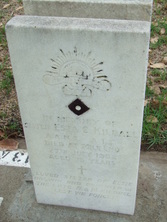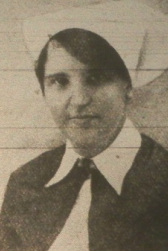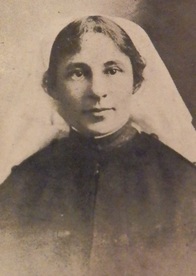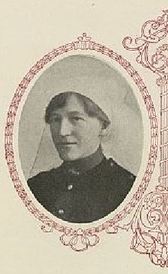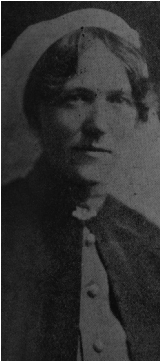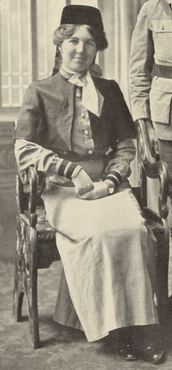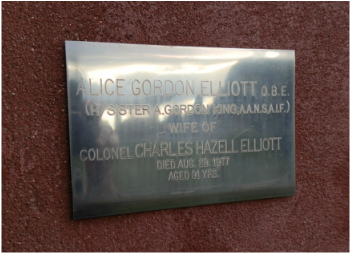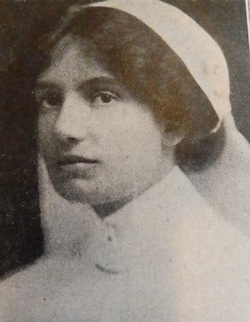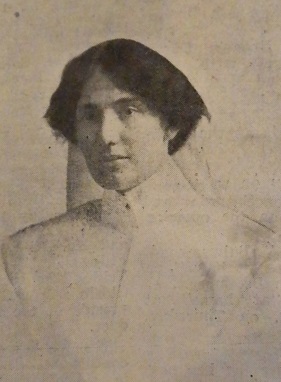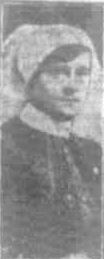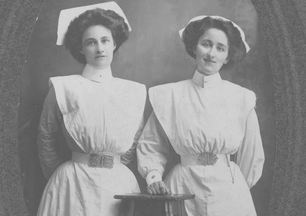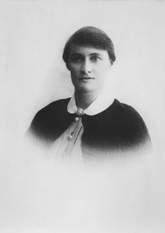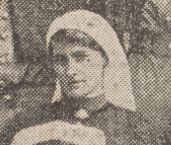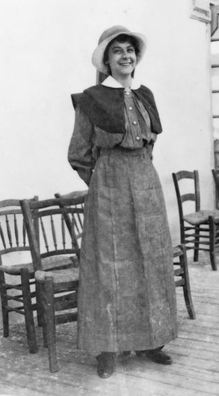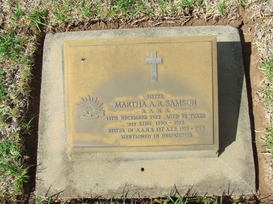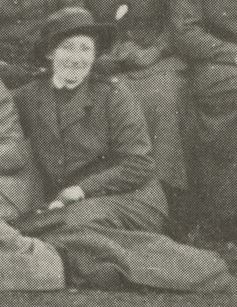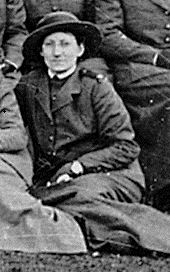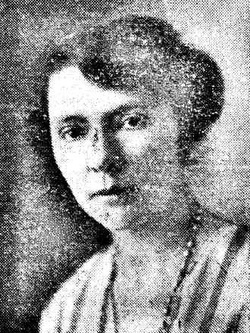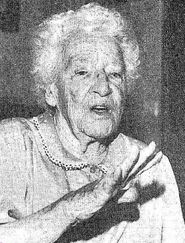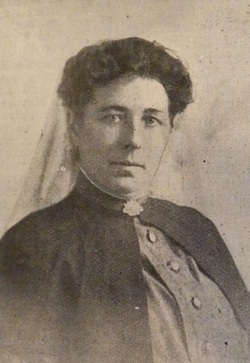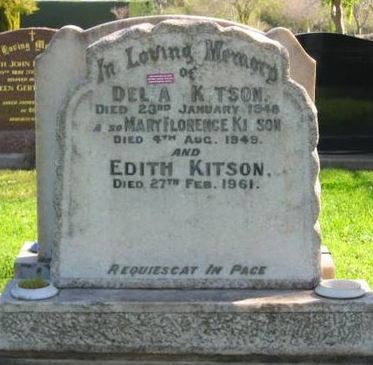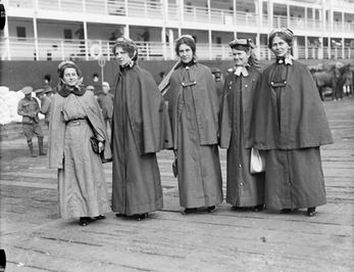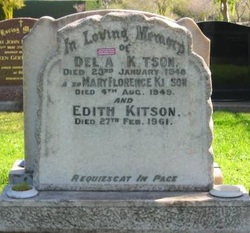KIDD, Ruby Gaurlay/Gourley
|
Matron
AANS – No 1 Section Sea Transport Born 1878 in Melbourne, Vic. Daughter of Thomas KIDD and Elizabeth Hannah nee GOURLAY Age 35 years Training Melbourne Children’s Hospital Enlisted 10 February 1915 Embarked 17 February 1915 Service aboard Hospital Ships and in England between transports Ships “Runic” “Suevic” “Demosthenes” “Themistocles” “Marathon” Promoted to Matron 01 March 1917 Returned to Australia 12 July 1919 per “City of Exeter” as Matron in charge Appointment terminated 01 February 1919 Did not marry Died 05 August 1965 in Vic. Resided Croydon, Vic. Buried 09 August 1965 at Springvale Botanical Cemetery Church of England Compartment I Section 2 Grave 2A |

Awarded Royal Red Cross 2nd Class
Date of Commonwealth of Australia Gazette: 25 July 1917
Location in Commonwealth of Australia Gazette: Page 1544, position 33
Date of London Gazette: 23 February 1917
Location in London Gazette: Page 1952, position 4
Date of Commonwealth of Australia Gazette: 25 July 1917
Location in Commonwealth of Australia Gazette: Page 1544, position 33
Date of London Gazette: 23 February 1917
Location in London Gazette: Page 1952, position 4
Yesterday word was received by Mr T, Kidd, "Athol," High street, Armadale, that his daughter, Matron Ruby Gourlay Kidd, had sailed by the City
of Exeter, which left England on July 12. For service rendered in connection with transports Miss Kidd was invested with the Royal Red Cross (Second Class) in March, 1917. She has served in France and England, but her special war duty was taking charge of hospital wards on transports carrying large numbers of troops from Australia to England, and returning on hospital transports with invalids. She left here on her last trip about ten months ago, and has since been on duty at Cobham Hall Hospital, Kent.
of Exeter, which left England on July 12. For service rendered in connection with transports Miss Kidd was invested with the Royal Red Cross (Second Class) in March, 1917. She has served in France and England, but her special war duty was taking charge of hospital wards on transports carrying large numbers of troops from Australia to England, and returning on hospital transports with invalids. She left here on her last trip about ten months ago, and has since been on duty at Cobham Hall Hospital, Kent.
KIDDLE, Lilian Bessie
Sister
Queen Alexandra's Imperial Military Nursing Service
Born Bessie KIDDLE 04 July 1889 at Kybybolite, SA
Daughter of Richard KIDDLE and Marion nee HALLIDAY
Of 'Tully Glen' Stawell, NSW
On 09 September 1920 she married Hugh Gordon HANNA at Scots Chruch, Collins St. Melbourne
Her son Robert Hugh Hanna was killed in New Guinea in 1942
She died in Walwa, Victoria in 1974.
Sister Lilian Kiddle, who wears the 'Mons' Medal (awarded to those who served with the first British army in France and Belgium), is returning to Melbourne by tho s.s. Demosthenes, after having spent four years in France with The Brisith Red Cross. She was personally congratulated by Field-Marshal Sir Douglas Haig for her work on ambulance trains behind the lines. Sister Kiddle is a daughter of Mr. Richard Kiddle.
The Border and Riverina Times Thursday 06 February 1919 page 3
DISTINGUISHED WAR NURSE.
By QUEEN BEE.
Last week Miss Lilian Kiddle, who was the first of 30 Army Sisters to cross from England to France, in October, 1914, returned to Melbourne. Her trials on first taking up duty were dreadful. Afterwards a more organised state of affairs came about. She nursed men of many nationalities, including Germans. Her collection of souvenirs tells her story. There is her apron pierced with shrapnel. Her electric torch was often the only light allowed an hospital for fear of air raids. Her passport is so covered with endorsements that it bears quite a history. Miss Kiddle was in the retreat from Mons, and side by side with her Royal Red Cross ribbon is the ribbon of her Mons Medal, awarded to those who rendered service with the first British Army in France and Belgium. More pleasant memories attend the fur-lined cape and muff, with large serge hood, Queen Alexandra's gifts to the first nurses. There is the
Duchess of Westminster's autographed photograph and arm badge worked with her coat-of-arms, farewell gifts, Sister Kiddle having practically concluded her services in her Grace's hospital. Even the cover on the table where on the souvenirs were displayed had its sorrowful history, for it was among the last pieces of linen and lacework done by the women of Lille. Extremely clever and devilish in its ingenious construction is the German sniper's mask in her possession, of the finest golden-brown gossamer, with the most beautifully and deftly worked eye holes, the only part of his face visible when the mask is on; while the colour makes it impossible to locate the wearer.
For the purpose of enabling these interesting souvenirs to be seen, Mrs. Richard Kiddle gave a small tea at The Waldorf, St. Kilda, on March 7,, when a company of relatives and old friends welcomed home her daughter, who had been abroad for six years. Miss Kiddle was in a smart frock, which she brought out with her, of black
taffeta, with a super-bodice of georgette, embroidered with gold, and a black velvet hat, set off by a gold rose. Before going to England, two years before the war Miss Kiddle trained at the Homoeopathic Hospital, St. Kilda road. Before leaving England she was personally congratulated by Sir Douglas Haig for her work on ambulance trains behind the lines. Sister Kiddle is the second daughter of Mr. and Mrs. Richard Kiddle, of New South Wales, and is niece of the late Mr. Lewis Kiddle and Mr. William Kiddle. Among the guests who welcomed her home with warmth and affection were Mrs. John Kiddle, Miss Marion Kiddle, Mrs. P. J. Brient, Mrs. Raynes Dickson, Mrs. Archibald Currie and Miss Currie, Miss Kelly, Mrs. Hubert Parker, and Mrs. G. Hodgson. Sister Kiddle describes in glowing terms the deeds of her countrymen, who, she says, very often saved an evacuation of hospital near the line by their bravery.
The Australasian Saturday 15 March 1919 page 35
Queen Alexandra's Imperial Military Nursing Service
Born Bessie KIDDLE 04 July 1889 at Kybybolite, SA
Daughter of Richard KIDDLE and Marion nee HALLIDAY
Of 'Tully Glen' Stawell, NSW
On 09 September 1920 she married Hugh Gordon HANNA at Scots Chruch, Collins St. Melbourne
Her son Robert Hugh Hanna was killed in New Guinea in 1942
She died in Walwa, Victoria in 1974.
Sister Lilian Kiddle, who wears the 'Mons' Medal (awarded to those who served with the first British army in France and Belgium), is returning to Melbourne by tho s.s. Demosthenes, after having spent four years in France with The Brisith Red Cross. She was personally congratulated by Field-Marshal Sir Douglas Haig for her work on ambulance trains behind the lines. Sister Kiddle is a daughter of Mr. Richard Kiddle.
The Border and Riverina Times Thursday 06 February 1919 page 3
DISTINGUISHED WAR NURSE.
By QUEEN BEE.
Last week Miss Lilian Kiddle, who was the first of 30 Army Sisters to cross from England to France, in October, 1914, returned to Melbourne. Her trials on first taking up duty were dreadful. Afterwards a more organised state of affairs came about. She nursed men of many nationalities, including Germans. Her collection of souvenirs tells her story. There is her apron pierced with shrapnel. Her electric torch was often the only light allowed an hospital for fear of air raids. Her passport is so covered with endorsements that it bears quite a history. Miss Kiddle was in the retreat from Mons, and side by side with her Royal Red Cross ribbon is the ribbon of her Mons Medal, awarded to those who rendered service with the first British Army in France and Belgium. More pleasant memories attend the fur-lined cape and muff, with large serge hood, Queen Alexandra's gifts to the first nurses. There is the
Duchess of Westminster's autographed photograph and arm badge worked with her coat-of-arms, farewell gifts, Sister Kiddle having practically concluded her services in her Grace's hospital. Even the cover on the table where on the souvenirs were displayed had its sorrowful history, for it was among the last pieces of linen and lacework done by the women of Lille. Extremely clever and devilish in its ingenious construction is the German sniper's mask in her possession, of the finest golden-brown gossamer, with the most beautifully and deftly worked eye holes, the only part of his face visible when the mask is on; while the colour makes it impossible to locate the wearer.
For the purpose of enabling these interesting souvenirs to be seen, Mrs. Richard Kiddle gave a small tea at The Waldorf, St. Kilda, on March 7,, when a company of relatives and old friends welcomed home her daughter, who had been abroad for six years. Miss Kiddle was in a smart frock, which she brought out with her, of black
taffeta, with a super-bodice of georgette, embroidered with gold, and a black velvet hat, set off by a gold rose. Before going to England, two years before the war Miss Kiddle trained at the Homoeopathic Hospital, St. Kilda road. Before leaving England she was personally congratulated by Sir Douglas Haig for her work on ambulance trains behind the lines. Sister Kiddle is the second daughter of Mr. and Mrs. Richard Kiddle, of New South Wales, and is niece of the late Mr. Lewis Kiddle and Mr. William Kiddle. Among the guests who welcomed her home with warmth and affection were Mrs. John Kiddle, Miss Marion Kiddle, Mrs. P. J. Brient, Mrs. Raynes Dickson, Mrs. Archibald Currie and Miss Currie, Miss Kelly, Mrs. Hubert Parker, and Mrs. G. Hodgson. Sister Kiddle describes in glowing terms the deeds of her countrymen, who, she says, very often saved an evacuation of hospital near the line by their bravery.
The Australasian Saturday 15 March 1919 page 35
KIERNAN, Irene Leonora
Sister
AANS
Born 10 April 1891 at Callington, SA
Daughter of Arthur KIERNAN and Margaret nee FITZPATRICK
Of Richardson St., Boulder City, WA
Trained at Fremantle Public Hospital
Enlisted 21 December 1916
Aged 25 years
Embarked 19 December 1916 from Sydney per 'Orontes'
Served in England
Returned to Australia 07 June 1918 per 'Suevic'
Re-embarked at Melbourne 23 July 1918 per 'Marathon'
Returned to Australia 03 November 1919 per 'Mahana'
Appointment terminated 18 December 1919
Did not marry
Died 1979 in Fremantle, WA
AANS
Born 10 April 1891 at Callington, SA
Daughter of Arthur KIERNAN and Margaret nee FITZPATRICK
Of Richardson St., Boulder City, WA
Trained at Fremantle Public Hospital
Enlisted 21 December 1916
Aged 25 years
Embarked 19 December 1916 from Sydney per 'Orontes'
Served in England
Returned to Australia 07 June 1918 per 'Suevic'
Re-embarked at Melbourne 23 July 1918 per 'Marathon'
Returned to Australia 03 November 1919 per 'Mahana'
Appointment terminated 18 December 1919
Did not marry
Died 1979 in Fremantle, WA
KILDAEL, Esta Cornelia
|
Staff Nurse
AANS Born 05 July 1876 at Adelaide, SA Daughter of Nekelais KILDAEL and Matilda nee LONG Of Gloucester Street, Prospect, SA Occupation prior to enlistment Nurse Aged 39 years Enlisted 05 November 1916 at Cairo, Egypt Served in France and England Returned to Australia 13 May 1919 per 'Dunluce Castle' Appointment terminated 21 July 1919 Did not marry Died 27 July 1952 at Mile End, SA Aged 75 years Resided Mile End, SA Buried West Terrace Cemetery Kendrew Oval |
Death Of Miss Kildael
One of the foundation members of the Returned Sisters' sub-branch of the RSL Miss E. Kildael, who died this week, was superintendent of nurses at the Adelaide Children's Hospital when she enlisted in the AANS in 1915 . During World War I, Miss Kildael served in Egypt, France and England. When she returned to South Australia in 1919 she resigned from the ACH and from active nursing. However, she retained her interest in the work and helped organise the nursing division of St. John Ambulance Brigade.
Advertiser Friday 8 August 1952 page 11
One of the foundation members of the Returned Sisters' sub-branch of the RSL Miss E. Kildael, who died this week, was superintendent of nurses at the Adelaide Children's Hospital when she enlisted in the AANS in 1915 . During World War I, Miss Kildael served in Egypt, France and England. When she returned to South Australia in 1919 she resigned from the ACH and from active nursing. However, she retained her interest in the work and helped organise the nursing division of St. John Ambulance Brigade.
Advertiser Friday 8 August 1952 page 11
KILDEA, Lucy Sylvester
Staff Nurse
AANS
Born 25 December 1884 in Caltowie, SA
Daughter of E M KILDEA
Age 34 years
Training Port Pirie Hospital
Enlisted 04 September 1917 at Keswick, SA
Embarked 13 September 1917 in Adelaide per “Runic”
Service Egypt
Ill with Dysentery November 1918 and Influenza January 1919
Medical board decision she was suffering Post Influenza debility
Invalided to Australia 02 April 1919 per “Kildonian Castle”
Medical discharge 28 June 1919
Married Colin Scott Moncrieff FINLAYSON
Family of 1 son
Died 29 March 1966 at Warwick Hospital, North Unley, SA
Cause of death Coronary Occlusion (1 day), Generalised Arteriosclerosis (15 years), Crush Fracture of Lumbar Vertebra (2 months) and Generalised Osteoporosis
Aged 82 years
Resided 49 King William Road, North Unley, SA
Buried Centennial Park Cemetery Derrick Gardens Path 3 Grave 24
AANS
Born 25 December 1884 in Caltowie, SA
Daughter of E M KILDEA
Age 34 years
Training Port Pirie Hospital
Enlisted 04 September 1917 at Keswick, SA
Embarked 13 September 1917 in Adelaide per “Runic”
Service Egypt
Ill with Dysentery November 1918 and Influenza January 1919
Medical board decision she was suffering Post Influenza debility
Invalided to Australia 02 April 1919 per “Kildonian Castle”
Medical discharge 28 June 1919
Married Colin Scott Moncrieff FINLAYSON
Family of 1 son
Died 29 March 1966 at Warwick Hospital, North Unley, SA
Cause of death Coronary Occlusion (1 day), Generalised Arteriosclerosis (15 years), Crush Fracture of Lumbar Vertebra (2 months) and Generalised Osteoporosis
Aged 82 years
Resided 49 King William Road, North Unley, SA
Buried Centennial Park Cemetery Derrick Gardens Path 3 Grave 24
FINLAYSON-KILDEA.-On the 6th August the marriage was solemnised by the Rev. Father Hymens, at St. Catherine's Church, Horsetain, Birmingham, England, between Captain C. S. M.Finlayson, Indian Army Reserve, and Miss Lucy Sylvester Kildea, daughter of Mrs. E. M. Kildea, of Glenelg, South Australia.
The Advertiser Friday 01 October 1920 page 6
The Advertiser Friday 01 October 1920 page 6
KILLICOAT, Frances Madge
|
Staff Nurse
AANS Born 04 March 1889 at Abberton Park near Redruth (Burra), SA Daughter of Philip Lander KILLICOAT and Mary nee CAVE Age 26 years Training Adelaide Hospital Enlisted 05 November 1915 Embarked 12 November 1915 in Melbourne per “Orsova” Service in Egypt, Marseilles and on the field in France Promoted to Sister 01 October 1918 Resigned appointment in England 18 November 1918 due to marriage Married Capt. Stewart Osborn COWEN of AAMC Repatriation contact 12 March 1959 Died 14 May 1974 in Armadale, Vic. Resided Armadale, Vic. Cremated 16 May 1974 at Springvale Botanical Cemetery and remains scattered |
KILSBY, Blanche Catherine
Staff Nurse
AANS
Born 17 December 1888 in Brunswick,Vic
Daughter of Francis KILSBY and Gwendoline nee REES
Address “Gowar” Burke Rd, East Malvern, Vic
Age 29 years
Training 4 years Melbourne Hospital
Enlisted 18 November 1917
Embarked 08 November 1917 in Sydney per “Canberra”
Service in India
Resigned Appointment due to marriage 04 August 1919
Married Charles Whittenbury of Ferncroft Ave, East Malvern, Vic
Died 14 December 1969 in Vic.
Resided Canterbury, Vic.
Cremated Springvale Botanical Cemetery and remains scattered
AANS
Born 17 December 1888 in Brunswick,Vic
Daughter of Francis KILSBY and Gwendoline nee REES
Address “Gowar” Burke Rd, East Malvern, Vic
Age 29 years
Training 4 years Melbourne Hospital
Enlisted 18 November 1917
Embarked 08 November 1917 in Sydney per “Canberra”
Service in India
Resigned Appointment due to marriage 04 August 1919
Married Charles Whittenbury of Ferncroft Ave, East Malvern, Vic
Died 14 December 1969 in Vic.
Resided Canterbury, Vic.
Cremated Springvale Botanical Cemetery and remains scattered
WHITTENBURY-KILSBY.-On the 4th August, at Rawl Pindi, India, Charles Whittenbury (England), to Sister Blanche Catherine, younger daughter of Mr. F. Kilsby, East Malvern.
The Argus Saturday 09 August 1919 page 13
The Argus Saturday 09 August 1919 page 13
KIMBER, Alice May
Staff Nurse
AANS
Born 21 June 1875 at Echunga, SA
Daughter of William KIMBER and Eliza nee HARRIS
Sister of Jessie Harris KIMBER
Age 39 years
Enlisted 11 December 1916
Embarked 18 December 1916 in Fremantle per “Kaiser-I-Hind”
Transport duty on “Aeneas” “Euripides” “Port Sydney” “Star of England”
Service in England between transports
Returned to Australia 02 March 1919 per “Derbyshire” On Duty
Appointment terminated 20 September 1919
Repatriation contact 10 March 1959
Did not marry
Died 11 September 1958 in Perth, WA
Aged 83 years
Resided Subiaco, WA
Ashes scattered over garden at Karrakatta Cemetery
AANS
Born 21 June 1875 at Echunga, SA
Daughter of William KIMBER and Eliza nee HARRIS
Sister of Jessie Harris KIMBER
Age 39 years
Enlisted 11 December 1916
Embarked 18 December 1916 in Fremantle per “Kaiser-I-Hind”
Transport duty on “Aeneas” “Euripides” “Port Sydney” “Star of England”
Service in England between transports
Returned to Australia 02 March 1919 per “Derbyshire” On Duty
Appointment terminated 20 September 1919
Repatriation contact 10 March 1959
Did not marry
Died 11 September 1958 in Perth, WA
Aged 83 years
Resided Subiaco, WA
Ashes scattered over garden at Karrakatta Cemetery
KINCAID, Edith Dudley
|
Staff Nurse
AANS Born 1882 Melbourne, Vic Daughter of John KINCAID and Maria Anne nee AVERY Address “Daraua” Hawthorn, Melbourne, Vic Age 33 years Enlisted 22 August 1916 Embarked 22 August 1916 in Melbourne per “Mooltan” Service in India 15 November 1917 – Medical Discharge imminent but….. Resigned Appointment due to marriage 26 November 1917 Died 1932 in Kew, Vic. |
Three days later 28 November 1917 diagnosed with Neurasthenia and medial discharge recommended, without knowledge of marriage.
Nurse Kincaid did not attend Medical Board Review
“Later discovered had secretly married B M Watson Australian Wireless Squadron at Poona 26 November 1917.”
Nurse Kincaid refused all medical involvement as “she felt quite well”.
Her medical discharge and secret marriage caused a flurry of administrative paperwork.
Punch Thursday 31 August 1916 page 21
Nurse Kincaid did not attend Medical Board Review
“Later discovered had secretly married B M Watson Australian Wireless Squadron at Poona 26 November 1917.”
Nurse Kincaid refused all medical involvement as “she felt quite well”.
Her medical discharge and secret marriage caused a flurry of administrative paperwork.
Punch Thursday 31 August 1916 page 21
KING, Agnes Wotherspoon
|
Sister
AANS Born 1884 at Birkenhead, England Daughter of Robert KING and Frances nee CRAIG Age 30 years Training Mansfield Public Hospital, Vic Enlisted 11 May 1915 Embarked 18 May 1915 per “Mooltan” Service in Egypt, France and England Ill with Rubella March 1917 Promoted to Sister 01 September 1917 Returned to Australia 15 January 1919 per “City of Exeter” On Duty Appointment terminated 24 April 1919 Became Matron of Caulfield Repatriation Hospital Died 03 April 1942 in Prahan, Vic. State Matron Resided Caulfield, Vic. Photograph Mansfield's Souvenir of the War 1914-1919 Read more here |
|
Matron King, Of Keswick Transfers To Brisbane
Matron Agnes King, of the Keswick Repatriation Hospital, will begin duty as matron of the Rosemount Repatriation Hospital, Brisbane, on November 2. She served as a sister during the Great War from 1915. She was matron of a country hospital in Victoria when she volunteered for war service and her experience in Egypt, France, and England included six months on an ambulance train in France. When she returned to Australia she was attached to the staff of the Caulfield Military Hospital from 1919 to 1927. Then she was matron at the Perth Repatriation Hospital for six years until she was transferred to a similar position at the Keswick Repatriation Hospital, Adelaide, three and a half years ago. Matron King will motor to Brisbane, leaving Adelaide this week-end. The Advertiser Friday 16 October 1936 page 35 |
Many Years Spent Nursing Soldiers
MATRON A. KING, of Rosemount Hospital, Brisbane, has spent many years in nursing returned soldiers. Ever since she went abroad in March, 1915, she has been attached to military hospitals.
On her return from England in 1919, Matron King went to the Caulfield Repatriation Hospital, Melbourne, and In 1927 she was promoted to matron of the Repatriation Sanatorium, Perth. From there she went to the Repatriation General Hospital, Keswick, South Australia, where she remained for three and a half years. In 1936 Matron King went to Brisbane to take charge at Rosemount.
She is very fond of motoring, and sees a good deal of the country in her own car. Some little time ago she made a tour of North Queensland.
The Australian Women's Weekly Saturday 12 March 1938 page 45
MATRON A. KING, of Rosemount Hospital, Brisbane, has spent many years in nursing returned soldiers. Ever since she went abroad in March, 1915, she has been attached to military hospitals.
On her return from England in 1919, Matron King went to the Caulfield Repatriation Hospital, Melbourne, and In 1927 she was promoted to matron of the Repatriation Sanatorium, Perth. From there she went to the Repatriation General Hospital, Keswick, South Australia, where she remained for three and a half years. In 1936 Matron King went to Brisbane to take charge at Rosemount.
She is very fond of motoring, and sees a good deal of the country in her own car. Some little time ago she made a tour of North Queensland.
The Australian Women's Weekly Saturday 12 March 1938 page 45
KING, Alice Gordon
|
Sister/Head Sister
AANS Born 21 August 1886 in Hobart, Tas. Daughter of William Westfol KING and Mary Ann nee FISHER Age 28 years Enlisted 26 September 1914 Embarked 20 October 1914 per “Geelong” Service on ships “Grantully Castle” and “Sicilia” at Mudros Harbour awaiting Gallipoli Landing Followed by transport from Cape Helles and Salonika to Egypt and/or Malta Then ship evacuation from Malta or Alexandria to England Further service in England and on the field in France Promoted to Head Sister 21 November 1917 Continued to do relieving work at Harefield Hospital after marriage Resigned appointment in England 20 December 1917 due to marriage Married Colonel Charles Hazell Elliott CMG DSO VD of 12th Battalion AIF in 1917 Awarded OBE Died 29 August 1977 in Hobart, Tas. Cremated 01 September 1977 Aged 91 years Resided Lindisfarne, Tas. Buried Cornelian Bay Cemetery Derwent Gardens Aust. Imp. Forces Arch 1 South 6 C |
ELLIOTT - KING - On December 20, 1917 at St. Marylebone Church, London, by Ven. Archdeacon Richard, of Tasmania, Lieutenant Col. Charles H Elliott, DSO 12th Battalion AIF son of late Robert Elliott of High Street, to Sister Alice G King, AANS only daughter of late W and Mrs King, of Omrah, Upper Murray Street, Hobart.
Read more here
Read more here
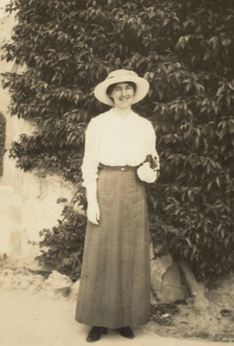
Alice Gordon Elliott (1886-1977), nurse and community worker, was born on 21 August 1886 in Hobart, only daughter of William Westfold King, jeweller, and his wife Mary Ann, née Fisher. Alice was educated locally at Miss D'Emden's Private School and later returned there as a teacher. She also worked as an estate-agent's clerk before training (1908-12) as a nurse at Hobart General Hospital where she stayed on as a sister. Joining the Australian Army Nursing Service in 1913, King began full-time service with the Australian Imperial Force in September 1914. Next month she sailed for the Middle East in the transport, Geelong.
After helping to establish hospitals in Egypt, Sister King spent twelve months in hospital ships in Mediterranean waters and was mentioned in dispatches for her work. In July 1916 she was sent to England. From April to August 1917 she had charge of the theatre ward of the 3rd Australian General Hospital in France, and was then transferred to the 1st Australian Casualty Clearing Station, Belgium. As part of the operating team, she worked long hours treating heavy casualties from engagements near Passchendaele. She was again posted to England in December.
On 20 December 1917 she married Lieutenant Colonel Charles Hazell Elliott (d.1956) at the parish church, St Marylebone, London. Although she had to resign from the A.I.F. on her marriage, she continued voluntary work until she and her husband embarked for Tasmania in 1919. The Elliotts set up house at New Town. Their only child was born in 1925. Alice was a generous, serious-minded and capable woman. Foundation president (1920) of the Returned Sisters' Association and an office-bearer until 1945, she was active on the house-committee of the R.S.A.'s memorial cottage at Lindisfarne which was established in 1924 as a holiday home for working nurses. She was also a foundation member (1922), first organizing secretary and treasurer of the Nurses Club, a professional centre, agency and residence. In 1929-44 she served on the management-committee of the Girls' Industrial School, New Town. A committee-member (1945-56) of the Ladies' Harbour Lights Guild of the Tasmanian branch of the Missions to Seamen, she helped the organization's fund-raising activities. She had been appointed a justice of the peace in 1924 and from 1936 to 1952 was a special magistrate in the Children's Court, Hobart.
During World War II, as commandant of a Voluntary Aid Detachment, Elliott lectured on war-nursing and acted as liaison officer with the civil defence authorities; in addition, she trained staff and oversaw the provision of dressings for local first-aid posts. In 1956 she was appointed O.B.E. and elected a life member of the Returned Sailors', Soldiers' and Airmen's Imperial League of Australia. Elliott had joined the Field Naturalists' Club in 1918 and became a life member in 1969. She enjoyed tennis until she was over 70. Survived by her son, she died on 29 August 1977 at Lindisfarne and was cremated. The Alice Elliott Day Club at the Repatriation General Hospital, Hobart, was named in her honour in 1987.
http://adb.anu.edu.au/biography/elliott-alice-gordon-10111
After helping to establish hospitals in Egypt, Sister King spent twelve months in hospital ships in Mediterranean waters and was mentioned in dispatches for her work. In July 1916 she was sent to England. From April to August 1917 she had charge of the theatre ward of the 3rd Australian General Hospital in France, and was then transferred to the 1st Australian Casualty Clearing Station, Belgium. As part of the operating team, she worked long hours treating heavy casualties from engagements near Passchendaele. She was again posted to England in December.
On 20 December 1917 she married Lieutenant Colonel Charles Hazell Elliott (d.1956) at the parish church, St Marylebone, London. Although she had to resign from the A.I.F. on her marriage, she continued voluntary work until she and her husband embarked for Tasmania in 1919. The Elliotts set up house at New Town. Their only child was born in 1925. Alice was a generous, serious-minded and capable woman. Foundation president (1920) of the Returned Sisters' Association and an office-bearer until 1945, she was active on the house-committee of the R.S.A.'s memorial cottage at Lindisfarne which was established in 1924 as a holiday home for working nurses. She was also a foundation member (1922), first organizing secretary and treasurer of the Nurses Club, a professional centre, agency and residence. In 1929-44 she served on the management-committee of the Girls' Industrial School, New Town. A committee-member (1945-56) of the Ladies' Harbour Lights Guild of the Tasmanian branch of the Missions to Seamen, she helped the organization's fund-raising activities. She had been appointed a justice of the peace in 1924 and from 1936 to 1952 was a special magistrate in the Children's Court, Hobart.
During World War II, as commandant of a Voluntary Aid Detachment, Elliott lectured on war-nursing and acted as liaison officer with the civil defence authorities; in addition, she trained staff and oversaw the provision of dressings for local first-aid posts. In 1956 she was appointed O.B.E. and elected a life member of the Returned Sailors', Soldiers' and Airmen's Imperial League of Australia. Elliott had joined the Field Naturalists' Club in 1918 and became a life member in 1969. She enjoyed tennis until she was over 70. Survived by her son, she died on 29 August 1977 at Lindisfarne and was cremated. The Alice Elliott Day Club at the Repatriation General Hospital, Hobart, was named in her honour in 1987.
http://adb.anu.edu.au/biography/elliott-alice-gordon-10111
KING, Amy
|
Sister
AANS Born 11 January 1882 in Brisbane, Qld. Daughter of Thomas Mulhall KING and Jane Maria nee MacDONNELL Of Brisbane, Qld. Age 32 years Training Homeopathic Hospital, Vic Enlisted 21 November 1914 Embarked 05 December 1914 Promoted to Sister 01 December 1915 Service in Egypt Died 1961 Photograph Table Talk Thursday 10 December 1914 page 22 |
Mentioned in Sir General JG Maxwell’s Despatches April 1916 for services in Egypt
Transport duty from Suez to Australia March 1916 per “Argyleshire”
Re-embarked 19 August 1916
Further service in Egypt then England and on the field in France
Contracted Trench Fever in September 1917
Awarded Royal Red Cross 2nd Class for services in the field Flanders and France
Returned to Australia 10 May 1919 In Charge
Discharged as medically unfit 17 April 1921
KING, Dorothy
Sister
Queen Alexandra's Imperial Military Nursing Service
Daughter of Frederick James KING and Mary nee WILSON
Miss Dorothy King, Guy's Hospital, London, late sister Q.A.I.M.N.S.R., has arrived in Brisbane, after four years' service in France and England, and is the guest of her mother and brother, Wybenville, Bayview terrace, Clayfield.
The Brisbane Courier Wednesday 03 September 1919 page 15
Queen Alexandra's Imperial Military Nursing Service
Daughter of Frederick James KING and Mary nee WILSON
Miss Dorothy King, Guy's Hospital, London, late sister Q.A.I.M.N.S.R., has arrived in Brisbane, after four years' service in France and England, and is the guest of her mother and brother, Wybenville, Bayview terrace, Clayfield.
The Brisbane Courier Wednesday 03 September 1919 page 15
KING, Eileen
|
Sister
Queen Alexandra's Imperial Military Nursing Service Born 1889 in Qld. Daughter of Thomas Mitchell KING and Jane Maria nee MacDONELL Of "Loorauah", Balaclava Road, Balaclava, Vic. Enlisted in QAIMNS 31 May 1915 Embarked for France 09 June 1915 Wounded by shrapnel in France 29 November 1917 Miss Loughran said she remembered the wounding of Sister King. In France, in 1917, they were at a casualty clearing station, and the Germans commenced to badly shell the area. The day sisters had all gone to bed when warning was received, and the patients were prepared for quick transference. Sister King was amid the din, but took no notice until she was thrown down, and, being unable to move, it was found that she was struck in the thigh and calf of the leg. She is convalescent, but still unable to get about. |

She was wounded by Hostile Bombs while on duty as above sustaining:
(1) Left Leg - A large deep wound 5" x 3" on post aspect lower half of leg, a smaller wound to inner side; calf muscles blown away and only deep ones left. Post Tibial nerve partially injured and she had 3 bruises on the left foot subsequently due to application of hot bottles to anaesthetic areas.
(2) Right thigh - wound of entry 2" x 1" outer side of mid third; exit wound 2" x 1" on post surface at higher level. No injury to bone, blood vessels or nerves.
Present state - wounds healed. Burns practically healed. Has some ...... power of left ankle which is rapidly improving - she can walk with crutches. She was suffering from great shock when admitted but is now much improved. - Recommended 2 months leave.
Her left leg which was seriously injured breaks down whenever she works for any length of time. The Board held on Feb 4th 1919, found that Sister King was unfit for work for a prolonged period, and recommended her return to Australia.
Medical Board finding on 05 July 1918 -Wounded GSW of Right Thigh and Left Leg - explosion of bomb - right thigh no disability, left leg great destruction of tissues of calf - limps - can walk 3 miles
"My old leg gives me quite a lot of trouble and the one that was not so badly wounded is not behaving at all well. I suppose it's because it has most of the work to do.
Col. Syme operated soon after I got home and broke down adhesions. I was in Hospital for over three months with that and when I left was practically as bad as before I started.
About a fortnight ago I started to take Millinery lessons, but don't know if I will be able to go on with these as I find it very tiring. I only hope I will as I have to do something and I will never be able to nurse again. I am getting a pension at the rate of £50 a year and that will be up in June. I do wish they would come to some definite arrangement so that I would know how my future stands, of course I am entirely dependent on myself and when one has not the strength its very hard to make a living at all, especially as things are at present."
Awarded Military Medal 29 January 1918
Permanently unfit 14 June 1918
Directed to join as Sister for Nursing Duty at the Sisters' Hospital, 71 Vincent Square, London on 15 July 1918
Passed fit for Home Service 22 November 1918
"I am directed to acquaint you that there is no regulation under which a Nurse could be granted a gratuity in respect of wounds." - 19 September 1919
Service terminated 07 June 1919 - 3 years 9 months service abroad
Applied for passage to Brisbane, Qld.- address listed as 'Glen Almond', St. Albans - father living in Qld
Embarked for Australia 08 May 1919 per 'Roda'
Eileen was one of 115 killed when a torpedo struck the Melbourne Star in April 1943.
Queensland Nurse Wounded.
Mr. K. M. King, secretary, and solicitor to the Local Authorities' Association, has received a cablegram from the War Office, London, stating that his sister, Nursing Sister Eileen King, was admitted on 3rd December to the 14th General Hospital, Wiirameru, France, suffering from severe bomb wounds. The left leg and right thigh were injured. Sister King is a daughter of Mr. T. M. King, I.S.O., of Brisbane, and was nursing in Melbourne, on Lady Dudley's staff, before enlisting for war service. A vote of sympathy ' with Mr. King was passed by the Coorparoo Shire Council last night.
The Telegraph Tuesday 11 December 1917 page 7
Sister Eileen King, daughter of Mrs. T. M. King, formerly Auditor General of Queensland, and sister of Mr. Hubert King, accountant at Reynolds, No 4 Bridge Street City, has been decorated by the King for bravery on the battlefield. Although wounded, Sister King remained and attended to the wounded soldiers. She is attached to the British Army Nursing Service.
Evening News (Sydney) Saturday 23 November 1918 page 4
ON NURSING DUTY.
Sister Amy King and Sister Eileen King, M.M., daughters of Mr. T.M. King, I.S.O., returned to Brisbane during the past week, and are at present staying with their sister, Mrs. P. A.Blundell, Erica, Coorparoo. Sister Amy King left in 1914 with a nursing unit. She was stationed in Egypt, and was one of those devoted women who bore the brunt of the arduous work in attending to the first returned wounded from Gallipoli in hospitals equipped for a comparatively small number only. Subsequently Sister Amy King was engaged in transport duty, and was tnen stationed in different places in France, including the clearing hospital at Aubigny, near Arras, where the work was very arduous and often heartbreaking. Sister Eileen King is the first Queensland nursing sister to bring back the Military Medal—an unusual honour for the nursing service. She left Australia with her unit early in 1916, and was sent on Special duty with the Queen Alexandra Nursing Unit to France, where for a year she was stationed at St. Omer. There were about 19 Australians included in the staff. Sister King was stationed later at Wimmereux, and subsequently at No. 63 clearing station, a post of danger near the firing line at Poperinghe, near Ypres, in Belgium. It was for her bravery there and her great devotion to duty under most trying circumstances that she was awarded the coveted decoration. The hospital in which were a large number of wounded soldiers was bombed, and the heroic women did the most gallant deeds in their work of rescue, continuing to remove their patients under fire to some of the wards which had been untouched. Sister King - was wounded, and still carries evidence of it in her lameness. "I was only able to save six of my men who had been injured," she said sadly. There were seven wards, and until the hospital was closed the wounded were cared for in the portions least affected by the bombs. Sister King was a patient in hospital for a considerable time, but the cheeriness of the Australian girls is on a plans with that of the Australian boys, who minimise troubles and find a gleam of sunshine somewhere.
Queenslander Saturday 09 August 1919 page 7
SISTER EILEEN KING, Military Medallist of the 1914-18 war, has now been presumed lost with other passengers on the Melbourne Star who were returning to Australia in April, 1943. Of the ship's passengers only two survivors are on record. Sister King was among the first 40 nurses to leave Australia in April, 1915, and was the youngest of these nurses who were on loan to England and enlisted with the Queen Alexandria Imperial Military Service Reserve. She did not return to Australia until 1918.
Army News Thursday 03 May 1945 page 2
(1) Left Leg - A large deep wound 5" x 3" on post aspect lower half of leg, a smaller wound to inner side; calf muscles blown away and only deep ones left. Post Tibial nerve partially injured and she had 3 bruises on the left foot subsequently due to application of hot bottles to anaesthetic areas.
(2) Right thigh - wound of entry 2" x 1" outer side of mid third; exit wound 2" x 1" on post surface at higher level. No injury to bone, blood vessels or nerves.
Present state - wounds healed. Burns practically healed. Has some ...... power of left ankle which is rapidly improving - she can walk with crutches. She was suffering from great shock when admitted but is now much improved. - Recommended 2 months leave.
Her left leg which was seriously injured breaks down whenever she works for any length of time. The Board held on Feb 4th 1919, found that Sister King was unfit for work for a prolonged period, and recommended her return to Australia.
Medical Board finding on 05 July 1918 -Wounded GSW of Right Thigh and Left Leg - explosion of bomb - right thigh no disability, left leg great destruction of tissues of calf - limps - can walk 3 miles
"My old leg gives me quite a lot of trouble and the one that was not so badly wounded is not behaving at all well. I suppose it's because it has most of the work to do.
Col. Syme operated soon after I got home and broke down adhesions. I was in Hospital for over three months with that and when I left was practically as bad as before I started.
About a fortnight ago I started to take Millinery lessons, but don't know if I will be able to go on with these as I find it very tiring. I only hope I will as I have to do something and I will never be able to nurse again. I am getting a pension at the rate of £50 a year and that will be up in June. I do wish they would come to some definite arrangement so that I would know how my future stands, of course I am entirely dependent on myself and when one has not the strength its very hard to make a living at all, especially as things are at present."
Awarded Military Medal 29 January 1918
Permanently unfit 14 June 1918
Directed to join as Sister for Nursing Duty at the Sisters' Hospital, 71 Vincent Square, London on 15 July 1918
Passed fit for Home Service 22 November 1918
"I am directed to acquaint you that there is no regulation under which a Nurse could be granted a gratuity in respect of wounds." - 19 September 1919
Service terminated 07 June 1919 - 3 years 9 months service abroad
Applied for passage to Brisbane, Qld.- address listed as 'Glen Almond', St. Albans - father living in Qld
Embarked for Australia 08 May 1919 per 'Roda'
Eileen was one of 115 killed when a torpedo struck the Melbourne Star in April 1943.
Queensland Nurse Wounded.
Mr. K. M. King, secretary, and solicitor to the Local Authorities' Association, has received a cablegram from the War Office, London, stating that his sister, Nursing Sister Eileen King, was admitted on 3rd December to the 14th General Hospital, Wiirameru, France, suffering from severe bomb wounds. The left leg and right thigh were injured. Sister King is a daughter of Mr. T. M. King, I.S.O., of Brisbane, and was nursing in Melbourne, on Lady Dudley's staff, before enlisting for war service. A vote of sympathy ' with Mr. King was passed by the Coorparoo Shire Council last night.
The Telegraph Tuesday 11 December 1917 page 7
Sister Eileen King, daughter of Mrs. T. M. King, formerly Auditor General of Queensland, and sister of Mr. Hubert King, accountant at Reynolds, No 4 Bridge Street City, has been decorated by the King for bravery on the battlefield. Although wounded, Sister King remained and attended to the wounded soldiers. She is attached to the British Army Nursing Service.
Evening News (Sydney) Saturday 23 November 1918 page 4
ON NURSING DUTY.
Sister Amy King and Sister Eileen King, M.M., daughters of Mr. T.M. King, I.S.O., returned to Brisbane during the past week, and are at present staying with their sister, Mrs. P. A.Blundell, Erica, Coorparoo. Sister Amy King left in 1914 with a nursing unit. She was stationed in Egypt, and was one of those devoted women who bore the brunt of the arduous work in attending to the first returned wounded from Gallipoli in hospitals equipped for a comparatively small number only. Subsequently Sister Amy King was engaged in transport duty, and was tnen stationed in different places in France, including the clearing hospital at Aubigny, near Arras, where the work was very arduous and often heartbreaking. Sister Eileen King is the first Queensland nursing sister to bring back the Military Medal—an unusual honour for the nursing service. She left Australia with her unit early in 1916, and was sent on Special duty with the Queen Alexandra Nursing Unit to France, where for a year she was stationed at St. Omer. There were about 19 Australians included in the staff. Sister King was stationed later at Wimmereux, and subsequently at No. 63 clearing station, a post of danger near the firing line at Poperinghe, near Ypres, in Belgium. It was for her bravery there and her great devotion to duty under most trying circumstances that she was awarded the coveted decoration. The hospital in which were a large number of wounded soldiers was bombed, and the heroic women did the most gallant deeds in their work of rescue, continuing to remove their patients under fire to some of the wards which had been untouched. Sister King - was wounded, and still carries evidence of it in her lameness. "I was only able to save six of my men who had been injured," she said sadly. There were seven wards, and until the hospital was closed the wounded were cared for in the portions least affected by the bombs. Sister King was a patient in hospital for a considerable time, but the cheeriness of the Australian girls is on a plans with that of the Australian boys, who minimise troubles and find a gleam of sunshine somewhere.
Queenslander Saturday 09 August 1919 page 7
SISTER EILEEN KING, Military Medallist of the 1914-18 war, has now been presumed lost with other passengers on the Melbourne Star who were returning to Australia in April, 1943. Of the ship's passengers only two survivors are on record. Sister King was among the first 40 nurses to leave Australia in April, 1915, and was the youngest of these nurses who were on loan to England and enlisted with the Queen Alexandria Imperial Military Service Reserve. She did not return to Australia until 1918.
Army News Thursday 03 May 1945 page 2

Awarded Military Medal
29 November 1917
The hospital in which were a large number of wounded soldiers was bombed, and the heroic women did the most gallant deeds in their work of rescue, continuing to remove their patients under fire to some of the wards which had been untouched.
Sister Eileen King,. MM, who has many friends in Australia, and who was seriously wounded in 1917 at a casualty clearing station, near the lines in France, on February 22, was invested at Buckingham Palace with the Military Medal for bravery on the field. The King made the investiture, and Nurse King was afterwards entertained at Marlborough House by Queen Alexandira, who personally presented her with a photograph and a book. She has now been invalided out of the service, she having been one of the first Australian nurses to enlist for active service.
Queensland Times Saturday 17 May 1919 page 8
29 November 1917
The hospital in which were a large number of wounded soldiers was bombed, and the heroic women did the most gallant deeds in their work of rescue, continuing to remove their patients under fire to some of the wards which had been untouched.
Sister Eileen King,. MM, who has many friends in Australia, and who was seriously wounded in 1917 at a casualty clearing station, near the lines in France, on February 22, was invested at Buckingham Palace with the Military Medal for bravery on the field. The King made the investiture, and Nurse King was afterwards entertained at Marlborough House by Queen Alexandira, who personally presented her with a photograph and a book. She has now been invalided out of the service, she having been one of the first Australian nurses to enlist for active service.
Queensland Times Saturday 17 May 1919 page 8
Bravery on the Field
Sister Eileen King, a trainee of the Homoeopathic Hospital, is the fourth Victorian nurse who has been awarded the Military Medal. Through injuries received during a bombardment at Proven, France, in 1917, she has had to give up all idea, of continuing her nursing career. One thigh has been injured, and part of the other limb blown away by a bomb. Notwithstanding her severe Injuries, Sister King would not desert her patients during the attack, and even when put right out of action the soldiers heard her say, "I have been hit. If you want anything come to me. I cannot reach you." Her condition was so critical that she had to be detained at a casualty clearing station for some time. Later she went to England and volunteered for duty, refusing a discharge and pension offered by the Imperial authorities. Sister King was a member of the Queen Alexandra Imperial Nursing Service. Her physical strength, however, was not equal to spirit and courage and very reluctantly Sister King left the service. She returned a few weeks ago by the Roda and is now in Brisbane gaining strength for another operation to her leg. Sister King is a niece of Mr Stephen King, Carlisle street. East St. Kllda.
Sister Eileen King, a trainee of the Homoeopathic Hospital, is the fourth Victorian nurse who has been awarded the Military Medal. Through injuries received during a bombardment at Proven, France, in 1917, she has had to give up all idea, of continuing her nursing career. One thigh has been injured, and part of the other limb blown away by a bomb. Notwithstanding her severe Injuries, Sister King would not desert her patients during the attack, and even when put right out of action the soldiers heard her say, "I have been hit. If you want anything come to me. I cannot reach you." Her condition was so critical that she had to be detained at a casualty clearing station for some time. Later she went to England and volunteered for duty, refusing a discharge and pension offered by the Imperial authorities. Sister King was a member of the Queen Alexandra Imperial Nursing Service. Her physical strength, however, was not equal to spirit and courage and very reluctantly Sister King left the service. She returned a few weeks ago by the Roda and is now in Brisbane gaining strength for another operation to her leg. Sister King is a niece of Mr Stephen King, Carlisle street. East St. Kllda.
KING, Elsie Muriel
Staff Nurse
AANS
Born 1886 at Bairnsdale, Vic.
Daughter of Leonard William KING and Sophie nee DUNN
Next of kin Mary DUNN
Enlisted 31 May 1917
Embarked 12 June 1917
Appointment terminated 13 November 1919
Married Robert John JONES
Matron of the leper station at Channel Island near Darwin
Died 17 May 1942 in Brisbane, Qld.
Matron Honoured
Matron Jones, who, after the war, as Sister King, was engaged in nursing in Hobart and Launceston, recently was honoured by His Majesty the King with the award of Officer of the Order of the British Empire. She was among several residents in the Northern Territory specially recommended for the honour. She had previously received the M.B.E. decoration, and this has been followed by the further distinction. The wife of Mr. R. J. Jones, son of Mrs. G. Auber Jones, formerly of Campbell Town, Matron Jones was a war nurse. As Sister King she served through the Great War with the A.I.F., and after her return took up bush nursing at the Katherine, where she was known for her sterling work in assisting the sick and suffering. On one occasion she saved the life of a constable, by riding 40 miles on horse-back through flooded country to set a broken limb and attend to his wounds. She afterwards took charge of the half-caste home at Alice Springs where her work and that of her husband was valuable. Following on their work there, they were appointed to their present positions of matron-and super-intendent of the Channel Island lazaret, where their useful work continues.
The Mercury Wednesday 12 January 1938 page 3s
War Nurse Recipient of M.B.E. in Honors List
MRS. R. J. JONES, of Darwin, who after the war, as Sister Elsie Muriel King, was engaged in nursing in Tasmania, was among the recipients of the M.B.E. in the New Year's honors list.
As Sister King she served through the Great War with the A.I.F. Sometime after her return she took up Bush Nursing at the Katherine, and she was noted for her sterling work in caring for the sick and suffering.
She was in charge of the half caste home at Alice Springs, where her husband, Mr. R. J. Jones, also did valuable work. Following on their work at the home, Mr. and Mrs Jones were appointed to their present positions of matron and superintendent of the Channel Island lazaret.
Australian Women's Weekly Saturday 05 February 1938 page 45
MATRON ELSIE JONES, M.B.E.
Word has been received of the death of Matron Elsie Muriel Jones, M.BE., which occurred at Brisbane yesterday. The deceased, who trained at the Gippsland Hospital was with her husband recently evacuated from the Channel Islands, about six miles north of Darwin. She was taken ill on the way to Brisbane.
Gippsland Times Monday 18 May 1942 page 1
AANS
Born 1886 at Bairnsdale, Vic.
Daughter of Leonard William KING and Sophie nee DUNN
Next of kin Mary DUNN
Enlisted 31 May 1917
Embarked 12 June 1917
Appointment terminated 13 November 1919
Married Robert John JONES
Matron of the leper station at Channel Island near Darwin
Died 17 May 1942 in Brisbane, Qld.
Matron Honoured
Matron Jones, who, after the war, as Sister King, was engaged in nursing in Hobart and Launceston, recently was honoured by His Majesty the King with the award of Officer of the Order of the British Empire. She was among several residents in the Northern Territory specially recommended for the honour. She had previously received the M.B.E. decoration, and this has been followed by the further distinction. The wife of Mr. R. J. Jones, son of Mrs. G. Auber Jones, formerly of Campbell Town, Matron Jones was a war nurse. As Sister King she served through the Great War with the A.I.F., and after her return took up bush nursing at the Katherine, where she was known for her sterling work in assisting the sick and suffering. On one occasion she saved the life of a constable, by riding 40 miles on horse-back through flooded country to set a broken limb and attend to his wounds. She afterwards took charge of the half-caste home at Alice Springs where her work and that of her husband was valuable. Following on their work there, they were appointed to their present positions of matron-and super-intendent of the Channel Island lazaret, where their useful work continues.
The Mercury Wednesday 12 January 1938 page 3s
War Nurse Recipient of M.B.E. in Honors List
MRS. R. J. JONES, of Darwin, who after the war, as Sister Elsie Muriel King, was engaged in nursing in Tasmania, was among the recipients of the M.B.E. in the New Year's honors list.
As Sister King she served through the Great War with the A.I.F. Sometime after her return she took up Bush Nursing at the Katherine, and she was noted for her sterling work in caring for the sick and suffering.
She was in charge of the half caste home at Alice Springs, where her husband, Mr. R. J. Jones, also did valuable work. Following on their work at the home, Mr. and Mrs Jones were appointed to their present positions of matron and superintendent of the Channel Island lazaret.
Australian Women's Weekly Saturday 05 February 1938 page 45
MATRON ELSIE JONES, M.B.E.
Word has been received of the death of Matron Elsie Muriel Jones, M.BE., which occurred at Brisbane yesterday. The deceased, who trained at the Gippsland Hospital was with her husband recently evacuated from the Channel Islands, about six miles north of Darwin. She was taken ill on the way to Brisbane.
Gippsland Times Monday 18 May 1942 page 1
KING, Esther Wynne
|
Sister
AANS Born 06 June 1888 at Sydney, NSW Daughter of Henry James KING and Lydia Knapp nee WHITFIELD Trained at Prince Alfred Hospital Aged 27 years Enlisted 13 April 1915 Embarked 13 April 1915 Service Egypt and England Promoted to Sister 04 April 1917 Transport duty Suez to Australia per “Ulysses” Re-embarked in Sydney 09 November 1918 per “Wiltshire” Service in India Returned to Australia 17 November 1919 per “Charon” Appointment terminated 04 May 1920 In 1919 she travelled to India to nurse in British Hospitals there. Married Thomas Page COOK in Orange NSW in 1920 Died 05 August 1980 in Brighton, Vic. Aged 92 years Buried Springvale Botanical Cemetery Garden of No Distant Place, May Date 11 Read more here |
KING, Lydia Kate
|
Staff Nurse/Sister
AANS Daughter of Henry James KING and Lydia Knapp nee WHITFIELD Age 29 years Enlisted 24 November 1914 Embarked 24 November 1914 per “Kyarra” Duty on hospital ship “Sicilia” transporting casualties from Cape Hellas, Anzac Cove, Lemnos Further transport duty on “Grantully Castle” “Euripides” “Ulysses” Promoted to Sister 01 December 1915 Resigned appointment in England 31 January 1917 due to marriage Married Herbert Gordon CARTER in England in 1917 Remained in England to nurse at Harefield Hospital until a few months before the birth of her first child. Died 1972 in NSW Her son John Whitfield Cook was a pilot officer in the RAF and was killed in 1944. Permalink: http://www.awm.gov.au/collection/P00401.001 |
KING, Martha Annie Ramsay (Pattie)
|
Staff Nurse
AANS Born 06 January 1890 at Kensington, SA Daughter of Stephen KING and Louisa Mercy Margaret nee BARNES Age 25 years Training Adelaide Hospital Enlisted 06 August 1915 Embarked 06 August 1915 per “Orontes Service Lemnos, Egypt, England and on the field in France Ill with Diphtheria November 1915 Influenza and Pneumonia November 1918; Influenza again February 1919 Promoted to Sister 01 October 1918 Mentioned in Sir Douglas Haig’s Despatches of 16 March 1919 Returned to Australia 04 July 1919 per “Norman” On Duty Appointment terminated 17 October 1919 Her sister Dorothy Samson died in February 1953 and Martha married the husband of her sister, Mortimer SAMSON in October 1953. She died 1982 and was interred Centennial Park, Adelaide. Buried Centennial Park Cemetery Derrick Gardens Path 28 Grave 885 Her father Stephen was a member of the final exploration team of John McDouall Stuart exploring expedition. www.awm.gov.au P01058.002 |
KING, Muriel
Staff Nurse
AANS
Born Bairnsdale, Vic.
Next of kin Mary DUNN
AANS
Born Bairnsdale, Vic.
Next of kin Mary DUNN
KINGSMILL, Ethel May
Sister
AANS
Born 25 October 1880 at Beltana, SA
Daughter of John William KINGSMILL and Annie nee PHILLIPSON
Sister to Mrs. PW MONCRIEFF
Age 35 years
Training Adelaide Hospital
Enlisted 03 August 1915
Embarked 25 November 1916 in Sydney per “Beltana”
Service in Salonika
Returned to Australia 30 May 1917 per “Beltana”
Re-enlisted 26 September 1918 at Keswick, SA
Embarked 14 October 1918 in Sydney per “Wyreema”
Service again, in Salonika
Returned to Australia 15 May 1919 per “Wyreema”
Appointment terminated 19 May 1919
Did not marry
Died 18 July 1952 in Armidale, NSW
Late of Armidale, NSW
AANS
Born 25 October 1880 at Beltana, SA
Daughter of John William KINGSMILL and Annie nee PHILLIPSON
Sister to Mrs. PW MONCRIEFF
Age 35 years
Training Adelaide Hospital
Enlisted 03 August 1915
Embarked 25 November 1916 in Sydney per “Beltana”
Service in Salonika
Returned to Australia 30 May 1917 per “Beltana”
Re-enlisted 26 September 1918 at Keswick, SA
Embarked 14 October 1918 in Sydney per “Wyreema”
Service again, in Salonika
Returned to Australia 15 May 1919 per “Wyreema”
Appointment terminated 19 May 1919
Did not marry
Died 18 July 1952 in Armidale, NSW
Late of Armidale, NSW
KINNANE, Florence Frances
Sister
AANS
Born 22 January 1891 in Hammond, SA
Daughter of Thomas KINNANE and Catherine Agnes nee HAYES
Age 25 years
Training North Adelaide Private Hospital
Enlisted 04 September 1917 at Keswick
Embarked 13 September 1917 in Melbourne per “Runic”
Service in Egypt and Salonika
Ill with Influenza August 1918
Returned to Australia 12 July 1919 per “City of Exeter” On Duty
Appointment terminated 22 September 1919
Arrived in USA in 1922 and was naturalised in 1936.
She married Edmond ROELOFSMA who played a bass clarinet with the New York Philharmonic Orchestra and also Philadelphia Philharmonic Orchestra.
AANS
Born 22 January 1891 in Hammond, SA
Daughter of Thomas KINNANE and Catherine Agnes nee HAYES
Age 25 years
Training North Adelaide Private Hospital
Enlisted 04 September 1917 at Keswick
Embarked 13 September 1917 in Melbourne per “Runic”
Service in Egypt and Salonika
Ill with Influenza August 1918
Returned to Australia 12 July 1919 per “City of Exeter” On Duty
Appointment terminated 22 September 1919
Arrived in USA in 1922 and was naturalised in 1936.
She married Edmond ROELOFSMA who played a bass clarinet with the New York Philharmonic Orchestra and also Philadelphia Philharmonic Orchestra.
KIRK, Myrtle Linda
|
Sister
AANS Born 1891 at Camperdown, Vic. Daughter of William John KIRK and Elizabeth nee BELL Age 26 years Training Alfred Hospital Enlisted 07 June 1917 Embarked 12 June 1917 in Melbourne per “Mooltan” Service in Salonika Automatically discharged upon marriage in Salonika 12 June 1918 Married Lieutenant Arthur O’Meara Despite being married she returned to Australia 22 July 1918 per “Kanowna” ON DUTY Residing at ‘The District Judge’s Residence’ in SUDAN by November 1923 |
KIRKCALDIE, Katherine Vida Methwen
Masseuse
AANS
Born 02 June 1885 in Burwood, NSW
Daughter of David KIRKCALDIE and Alice Angela KIRKCALDIE
Age 30 years
Enlisted 30 August 1915
Embarked 31 August 1915
Service Egypt and England
Ill with Influenza June 1916 and Chicken Pox February 1918
Returned to Australia 15 September 1918 per “Arawa”
Appointment Terminated 17 November 1918
Died 1978 in NSW
AANS
Born 02 June 1885 in Burwood, NSW
Daughter of David KIRKCALDIE and Alice Angela KIRKCALDIE
Age 30 years
Enlisted 30 August 1915
Embarked 31 August 1915
Service Egypt and England
Ill with Influenza June 1916 and Chicken Pox February 1918
Returned to Australia 15 September 1918 per “Arawa”
Appointment Terminated 17 November 1918
Died 1978 in NSW
KIRKCALDIE, Rosa Angela
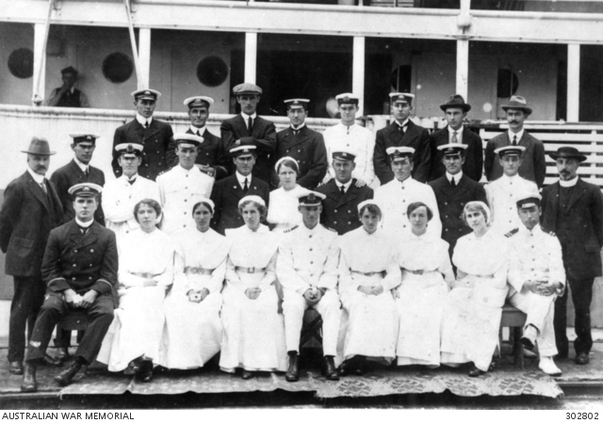 Australian hospital ship AMFA Grantala - front row 2nd nurse from right
Australian hospital ship AMFA Grantala - front row 2nd nurse from right
Sister
Queen Alexandra's Imperial Military Nursing Service Reserve
Born 03 June 1887 in Sydney, NSW
Daughter of David and Alice Angela KIRKCALDIE
Of 81 Woolcote Street, Darling Point, Sydney, NSW
Educated at Presbyterian Ladies College, Sydney
Trained at Royal Prince Alfred Hospital, Sydney March 1910 to March 1914
Enlisted with RAN
Appointed as Nursing Sister to Hospital Ship HMAS 'Grantala' 27 August 1914 to New Guinea
Discharged 23 December 1914
Tried to join the Army but was refused.
Left for England on the 'Ballarat' 20 February 1915
Appointed to QAIMNSR with rank of Staff Nurse 15 May 1915
Embarked for Malta 15 May 1915
To Hospital ship 'Panama' 31 October 1915
Appointed acting sister 01 July 1916
8th General Hospital 20 October 1916
Abbeville 20 March 1917
8 CCS 01 April 1914
Awarded three weeks' leave in May 1917 because of Debility, due to strain of active service.
6 CCS 13 June 1917
Appointed Acting Sister 01 July 1917
England duty 07 July 1917
Discharged 15 November 1917
Returned per 'Runic' 1918
In 1920 resided 'Canonbury' Darling Point, Sydney, NSW
Died 04 August 1972 in the district of St. Leonards, NSW
Late of Collaroy, NSW
Nurses Kirkaldie and Wellmann, of Sydney, left for England by the steamer Ballarat, "which sailed from the Outer Harbor yesterday. They hope to be sent to the front, their experience of war nursing, which they received on the Grantala, has by no means satisfied them, and they are longing for still harder work.
The Daily Herald Thursday 04 March 1915 page 4
"IN GREY AND SCARLET."
"In Gray and Scarlet" (Alexander McCubbin) is the name of an interesting little book of her war service by Sister R. A. Kirkcaldie, at present secretary to the Bush Nursing Association of New South Wales. Sister Klrkcaldie's first war experience was at Rabaul, whither she went on the Grantala. After returning from Rabaul she paid her own passage to London, and joined the Queen Alexandra's Imperial Military Nursing Service Reserve, known, for short, as the Q.A.I.M.N.5.R., and had experience both in Malta, during the Gallipoli campaign, and in France. Sister Kirkcaldie tells again the story of heroism of the wounded, and their wonderful fortitude in suffering, and brightens her book with some really good stories, especially of the inelastic routine of the War Office,and other worries over which the nurses who endured them can now look back and laugh.
The Queenslander Saturday 12 May 1923 page 3
IN GREY AND SCARLET
Few non-combatants, or for the matter of that few combatants, can have had such varied war service as Sister R. A. Kircaldie, whose experiences are described In "In Greyand Scarlet." In August, 1914, the author had recently completed her training in Prince Alfred Hospital, Sydney. On the outbreak of war she secured a post on the hospital ship Grantala, which accompanied the expedition to Rabaul. When the military operations were over, the vessel went to Fiji to be at hand in case the Australia should encounter the Scharnhorst and Gneisonau. But the German warships were on their way to South American waters, and when the news of the battle of Coronel came through, the Grantala returned to Sydney, where she was paid off. Sister Kircaldie was told that it was most improbable that any more Australian nurses would be sent abroad -little did we foresee then what the future held so with a friend she went to England, and joined Queen Alexandra's Imperial Military Nursing Reserve, more conveniently known as Q.A.I.M.N.S.R,
In due course she was appointed to a hospital In Malta, and made the acquaintance of the wily "Malt," who, whatever bis native virtues, is rather exasperating as an orderly, especially when one cannot speak his language. Two of them, by the way, blossomed out as opera singers, rather to the author's surprise. Tho opera was the chief. Indeed the only, diversion in Malta, and was much patronised by sisters escorted by officers. A stern edict came from headquarters that: "In future sisters will only be permitted to go to the opera in family parties suitably chaperoned." Next day an advertisement appeared in the Malta "Chronicle":-"Wanted, an elderly chaperon to accompany family parties to the opera." Sister Kircaldie Is not aware whether there were any applicants for the position. Certainly no chaperons were evers een in the opera-house. The author's first M.C. was a middle-aged doctor, who had practised all his life In a small English village. He would have been quite at home in a measles or typhoid hospital, but frankly admitted that he know nothing about modern surgery. Still it was not only In the Imperial Army that square pegs were chosen for round holes. In tho A.M.C. In Egypt was not a very distinguished Surgeon set to treat cases of measles, while an eminent physician a professor of medicine in an Australian University was detailed to issue stores?
To Malta many of the casualties from Gallipoli were sent. The report of the Royal Commission has already referred to the inadequacy of the arrangements for the transport and care of the wounded, and Sister Kircaldie bears grim testimony to the same effect. The endurance and cheerfulness of the sufferers was a cause of unfailing wonder and admiration to her. At the end of October 1916, she joined the hospital ship Panama, which went to the Peninsula and reached Suvla just after the great storm of sinister memory. On the beach were hundreds and hundreds of men, starving and crippled with frost bite. The Panama had accommodation for 400 patients; on this trip she carried 1172! After the evacuation the Panama proceeded up the Adriatic to an Albanian port to take off a stranded Red Cross unit and some Serbian refugees. France was the next scene of the author's labours. She was stationed in turn at Rouen, Abbeville, and Arras. Then at a large military hospital in Lancashire, and then back to Australia, after more than three years' of war service of which she has written in a most vivid and interesting fashion. (Alexander McCubbin, Robertson and Mullon.)
The Sydney Morning Herald Saturday 16 June 1923 page 8
Queen Alexandra's Imperial Military Nursing Service Reserve
Born 03 June 1887 in Sydney, NSW
Daughter of David and Alice Angela KIRKCALDIE
Of 81 Woolcote Street, Darling Point, Sydney, NSW
Educated at Presbyterian Ladies College, Sydney
Trained at Royal Prince Alfred Hospital, Sydney March 1910 to March 1914
Enlisted with RAN
Appointed as Nursing Sister to Hospital Ship HMAS 'Grantala' 27 August 1914 to New Guinea
Discharged 23 December 1914
Tried to join the Army but was refused.
Left for England on the 'Ballarat' 20 February 1915
Appointed to QAIMNSR with rank of Staff Nurse 15 May 1915
Embarked for Malta 15 May 1915
To Hospital ship 'Panama' 31 October 1915
Appointed acting sister 01 July 1916
8th General Hospital 20 October 1916
Abbeville 20 March 1917
8 CCS 01 April 1914
Awarded three weeks' leave in May 1917 because of Debility, due to strain of active service.
6 CCS 13 June 1917
Appointed Acting Sister 01 July 1917
England duty 07 July 1917
Discharged 15 November 1917
Returned per 'Runic' 1918
In 1920 resided 'Canonbury' Darling Point, Sydney, NSW
Died 04 August 1972 in the district of St. Leonards, NSW
Late of Collaroy, NSW
Nurses Kirkaldie and Wellmann, of Sydney, left for England by the steamer Ballarat, "which sailed from the Outer Harbor yesterday. They hope to be sent to the front, their experience of war nursing, which they received on the Grantala, has by no means satisfied them, and they are longing for still harder work.
The Daily Herald Thursday 04 March 1915 page 4
"IN GREY AND SCARLET."
"In Gray and Scarlet" (Alexander McCubbin) is the name of an interesting little book of her war service by Sister R. A. Kirkcaldie, at present secretary to the Bush Nursing Association of New South Wales. Sister Klrkcaldie's first war experience was at Rabaul, whither she went on the Grantala. After returning from Rabaul she paid her own passage to London, and joined the Queen Alexandra's Imperial Military Nursing Service Reserve, known, for short, as the Q.A.I.M.N.5.R., and had experience both in Malta, during the Gallipoli campaign, and in France. Sister Kirkcaldie tells again the story of heroism of the wounded, and their wonderful fortitude in suffering, and brightens her book with some really good stories, especially of the inelastic routine of the War Office,and other worries over which the nurses who endured them can now look back and laugh.
The Queenslander Saturday 12 May 1923 page 3
IN GREY AND SCARLET
Few non-combatants, or for the matter of that few combatants, can have had such varied war service as Sister R. A. Kircaldie, whose experiences are described In "In Greyand Scarlet." In August, 1914, the author had recently completed her training in Prince Alfred Hospital, Sydney. On the outbreak of war she secured a post on the hospital ship Grantala, which accompanied the expedition to Rabaul. When the military operations were over, the vessel went to Fiji to be at hand in case the Australia should encounter the Scharnhorst and Gneisonau. But the German warships were on their way to South American waters, and when the news of the battle of Coronel came through, the Grantala returned to Sydney, where she was paid off. Sister Kircaldie was told that it was most improbable that any more Australian nurses would be sent abroad -little did we foresee then what the future held so with a friend she went to England, and joined Queen Alexandra's Imperial Military Nursing Reserve, more conveniently known as Q.A.I.M.N.S.R,
In due course she was appointed to a hospital In Malta, and made the acquaintance of the wily "Malt," who, whatever bis native virtues, is rather exasperating as an orderly, especially when one cannot speak his language. Two of them, by the way, blossomed out as opera singers, rather to the author's surprise. Tho opera was the chief. Indeed the only, diversion in Malta, and was much patronised by sisters escorted by officers. A stern edict came from headquarters that: "In future sisters will only be permitted to go to the opera in family parties suitably chaperoned." Next day an advertisement appeared in the Malta "Chronicle":-"Wanted, an elderly chaperon to accompany family parties to the opera." Sister Kircaldie Is not aware whether there were any applicants for the position. Certainly no chaperons were evers een in the opera-house. The author's first M.C. was a middle-aged doctor, who had practised all his life In a small English village. He would have been quite at home in a measles or typhoid hospital, but frankly admitted that he know nothing about modern surgery. Still it was not only In the Imperial Army that square pegs were chosen for round holes. In tho A.M.C. In Egypt was not a very distinguished Surgeon set to treat cases of measles, while an eminent physician a professor of medicine in an Australian University was detailed to issue stores?
To Malta many of the casualties from Gallipoli were sent. The report of the Royal Commission has already referred to the inadequacy of the arrangements for the transport and care of the wounded, and Sister Kircaldie bears grim testimony to the same effect. The endurance and cheerfulness of the sufferers was a cause of unfailing wonder and admiration to her. At the end of October 1916, she joined the hospital ship Panama, which went to the Peninsula and reached Suvla just after the great storm of sinister memory. On the beach were hundreds and hundreds of men, starving and crippled with frost bite. The Panama had accommodation for 400 patients; on this trip she carried 1172! After the evacuation the Panama proceeded up the Adriatic to an Albanian port to take off a stranded Red Cross unit and some Serbian refugees. France was the next scene of the author's labours. She was stationed in turn at Rouen, Abbeville, and Arras. Then at a large military hospital in Lancashire, and then back to Australia, after more than three years' of war service of which she has written in a most vivid and interesting fashion. (Alexander McCubbin, Robertson and Mullon.)
The Sydney Morning Herald Saturday 16 June 1923 page 8
|
MATRON KIRKCALDIE, M.B.E.
With a fine record of hospital work during the war and a post war record of hospital advancement, Miss Rosa A. Kirkcaldie, matron of the Royal Alexandra Hospital for Children, Camperdown,has been honoured with an M.B.E. At the end of her nursing training, Matron Kirkcaldie wen twith the First Australian Expedition to New Guinea on the hospital ship, Grantala. Later, she joined up with the Q.A.I.M.N.S.R. in London as nursing sister. After years of war work, which took herto Malta, the Dardanelles, and France, she returned to Australia, and was appointed acting assistant matron of Prince Alfred Hospital. For two years, she was matron of the A.J.C. Home for Incapacitated Soldiers at Canonbury, and for another two years was assistant secretary to the Bush Nursing Association. During this period she wrote a book, "In Grey and Scarlet." For 11 years now, she has been matron at the Children's Hospital, Camperdown, and concentrated her efforts in making the hospital efficient rather than accommodating more beds. At the moment, she is attempting to establish a preliminary training school for nurses. She has travelled a great deal investigating thoroughly hospital work in England and America. The Sydney Morning Herald Thursday 06 June 1935 page 12s |
KIRKHAM, Laurie Hemsley
|
Sister
AANS Born 15 June 1890 at Ashbourne, SA Daughter of Tom KIRKHAM and Elizabeth nee BAYLY Of 'Gildholme' Ashbourne, SA Aged 25 years Enlisted 20 July 1915 Embarked 06 August 1915 per 'Orontes' Abscess Face admitted at Heliopolis 06 January 1916 Served in England Returned to Australia 03 September 1919 per 'Euripides' Appointment terminated 22 December 1919 Married Hedley Wilson VICKERS Died 18 February 1972 at Daw Park, SA Aged 81 years Resided St. Peters, SA Buried Mitcham Cemetery, SA |
KIRKHAM, Sarah Alice
World War I nurse gets to another milestone
By FRANK CRANSTON
She volunteered when what they used to call "the war to end all wars" started. And she served right through, because they desperately needed people with her qualifications....even if it would be sometime before they recognised how desperately.
Sarah Alice Kirkham had not been in Australia long when, in August, 1914, the Labor Prime Minister, Andrew Fisher, pledged the country would support Britain "to the last man and the last shilling".
Born in Darwin, Lancashire, she seemed destined to spend her life in the cotton industry, working her way up to weaver in one of the grimy mills.
She had always wanted to be a nurse but in those days, and in that England, nursing was still considered a profession for the more genteel sections of the population. There was just a chance that if she went to Australia she might get an opportunity so, in 1910, that was just
what she did. Almost immediately on arriving in Fremantle she was offered a chance— as a probationary trainee at the Fremantle Hospital. Four years later she completed her nurse's training. With orders to mobilise, the Army recognised that it would need a corps of nurses for the Australian Imperial Force, just as it had during the South African war.
Alice Kirkham was among the first to offer her services. "We were in a hospital near Cairo,which had been converted from a great big mansion," she recalled in Canberra yesterday. "It had been some sort of palace. "There we treated the last of the wounded who came off Gallipoli.They needed us there for about eight months."
After Cairo, the nursing group to which Sarah Kirkham was attached was sent to France. She has forgotten the unit's exact designation and her discharge certificate contains no detail.
In France she would be exposed to the full horror of what modern warfare could do to men's bodies. Much of it seems to have blotted itself from her memory, though she recalls great stress being laid on helping to keep alive the spirits of the wounded. "There were some very sad cases but of course we felt sorry for them all," she said. She felt particularly for the German wounded, for whom they cared. "They were delightful people, once they understood that we really were interested in helping them," she said.
She remembers being busy all the time she was in France and she must certainly have done her job well. She was promoted from staff nurse to sister. On Armistice Day, when the guns fell quiet, they all felt the relief physically. A regimental padre took Sarah and another sister to Paris for the celebrations. Everybody rushed to get demobilised but the nurses were asked to stay with the wounded until things could be sorted out. Sarah stayed and was not discharged from the AIF until January 14, 1920.
But the treatment of wounded soldiers was something to which she had become accustomed. When asked if she would accept a position at one of the new repatriation hospitals, she agreed. That was where she met Frank Linden, whom she married.
A diminutive woman, she has memories of World War I which, if compiled, would probably make a valuable contribution to the national archives. She served as long as any of the men and lived through much of the same horror.
For a few years after the war she kept in touch with some of her companions and some of their former patients. Gradually they all drifted away. Now there would be few left anyway.
Former Staff Nurse and then Sister Sarah Alice Kirkham, later just plain Mrs Frank Linden, celebrates her 100th birthday today.
The Canberra Times Thursday 29 November 1984 page 3
By FRANK CRANSTON
She volunteered when what they used to call "the war to end all wars" started. And she served right through, because they desperately needed people with her qualifications....even if it would be sometime before they recognised how desperately.
Sarah Alice Kirkham had not been in Australia long when, in August, 1914, the Labor Prime Minister, Andrew Fisher, pledged the country would support Britain "to the last man and the last shilling".
Born in Darwin, Lancashire, she seemed destined to spend her life in the cotton industry, working her way up to weaver in one of the grimy mills.
She had always wanted to be a nurse but in those days, and in that England, nursing was still considered a profession for the more genteel sections of the population. There was just a chance that if she went to Australia she might get an opportunity so, in 1910, that was just
what she did. Almost immediately on arriving in Fremantle she was offered a chance— as a probationary trainee at the Fremantle Hospital. Four years later she completed her nurse's training. With orders to mobilise, the Army recognised that it would need a corps of nurses for the Australian Imperial Force, just as it had during the South African war.
Alice Kirkham was among the first to offer her services. "We were in a hospital near Cairo,which had been converted from a great big mansion," she recalled in Canberra yesterday. "It had been some sort of palace. "There we treated the last of the wounded who came off Gallipoli.They needed us there for about eight months."
After Cairo, the nursing group to which Sarah Kirkham was attached was sent to France. She has forgotten the unit's exact designation and her discharge certificate contains no detail.
In France she would be exposed to the full horror of what modern warfare could do to men's bodies. Much of it seems to have blotted itself from her memory, though she recalls great stress being laid on helping to keep alive the spirits of the wounded. "There were some very sad cases but of course we felt sorry for them all," she said. She felt particularly for the German wounded, for whom they cared. "They were delightful people, once they understood that we really were interested in helping them," she said.
She remembers being busy all the time she was in France and she must certainly have done her job well. She was promoted from staff nurse to sister. On Armistice Day, when the guns fell quiet, they all felt the relief physically. A regimental padre took Sarah and another sister to Paris for the celebrations. Everybody rushed to get demobilised but the nurses were asked to stay with the wounded until things could be sorted out. Sarah stayed and was not discharged from the AIF until January 14, 1920.
But the treatment of wounded soldiers was something to which she had become accustomed. When asked if she would accept a position at one of the new repatriation hospitals, she agreed. That was where she met Frank Linden, whom she married.
A diminutive woman, she has memories of World War I which, if compiled, would probably make a valuable contribution to the national archives. She served as long as any of the men and lived through much of the same horror.
For a few years after the war she kept in touch with some of her companions and some of their former patients. Gradually they all drifted away. Now there would be few left anyway.
Former Staff Nurse and then Sister Sarah Alice Kirkham, later just plain Mrs Frank Linden, celebrates her 100th birthday today.
The Canberra Times Thursday 29 November 1984 page 3
KIRTON, Dora Pattie
Sister – Medical and Surgical
AANS
Born 1884 at Tendring, Essex, England
Daughter of Richard Gervase KIRTON and Mary Ann nee MANN
Age 31 years
Training Fremantle Public Hospital
Enlisted 10 August 1915
Embarked 11 August 1915
Duty on transport ship “Wandilla” from Suez to Australia
Re-embarked “Wandilla” for England
Service in England, France and on the field
Returned to Australia 08 October 1919 per “Benalla”
Appointment terminated 21 June 1920
Married name Cecil E ALCORN
Died 15 August 1965 in NSW
Late of Artarmon
AANS
Born 1884 at Tendring, Essex, England
Daughter of Richard Gervase KIRTON and Mary Ann nee MANN
Age 31 years
Training Fremantle Public Hospital
Enlisted 10 August 1915
Embarked 11 August 1915
Duty on transport ship “Wandilla” from Suez to Australia
Re-embarked “Wandilla” for England
Service in England, France and on the field
Returned to Australia 08 October 1919 per “Benalla”
Appointment terminated 21 June 1920
Married name Cecil E ALCORN
Died 15 August 1965 in NSW
Late of Artarmon
KISSACK, Martha
Staff Nurse
AANS
Born 1879 at Benalla, Vic
Daughter of Robert KISSACK and Martha nee WALKER
Address Nunn St, Benalla, Vic
Age 32 years
Training 3 years Colac Public Hospital
Enlisted 15 June 1917
Embarked 30 June 1917 in Melbourne per “Somali”
Service in Bombay
Returned to Australia per “Eastern” 13 April 1919
Appointment Terminated 20 August 1919
Did not marry
Died 22 June 1964
Resided Benalla, Vic.
Buried Benalla Cemetery
AANS
Born 1879 at Benalla, Vic
Daughter of Robert KISSACK and Martha nee WALKER
Address Nunn St, Benalla, Vic
Age 32 years
Training 3 years Colac Public Hospital
Enlisted 15 June 1917
Embarked 30 June 1917 in Melbourne per “Somali”
Service in Bombay
Returned to Australia per “Eastern” 13 April 1919
Appointment Terminated 20 August 1919
Did not marry
Died 22 June 1964
Resided Benalla, Vic.
Buried Benalla Cemetery
KITCHEN, Alice Elizabeth Barrett
|
Sister
AANS Daughter of William Barrett KITCHEN and Mary Ann nee CONWAYER Of 337 Sydney Road, Brunswick, Vic. Age 27 years Enlisted 26 September 1914 Embarked 19 October 1914 Transport duty to and from Dardanelles with wounded Service in Egypt, England, France and on the field Returned to Australia 28 August 1919 per “Kanowna” On Duty Appointment terminated 05 March 1920 Died 17 June 1950 at Edithvale, Vic. Resided 318 Nepean Highway, Edithvale, Vic. Punch Thursday 03 December 1914 page 26 KITCHIN. —On June 17, 1950 at her home, 318 Nepean Highway, Edithvale, Alice, late A.A.N.S., 1st A.I.F.. loved sister of Minnie (deceased) and Madge. — R.I.P. |
KITSON, Caroline Edith
|
Staff Nurse
AANS Born 04 April 1888 at Caltowie, SA Daughter of Patrick KITSON and Caroline Carter nee POTTS Sister of Delia KITSON - AANS Age 29 years Training Adelaide Hospital Enlisted 17 April 1917 at Keswick, SA Embarked 30 May 1917 in Adelaide per “Khiva” Service briefly India then Egypt Returned to Australia 25 December 1918 per “Nestor” Appointment terminated 30 April 1919 Repatriation contact 20 April 1959 Did not marry Died 27 February 1961 at Eastwood, SA Aged 72 years Resided Dulwich, SA Buried Centennial Park Cemetery Catholic Path 11 Grave 795 B |
KITSON, Delia
|
Sister
AANS Born 04 April 1888 at Caltowie, SA Daughter of Patrick KITSON and Caroline Carter nee POTTS Sister to Caroline Edith KITSON – AANS Age 25 years Training Adelaide Hospital Enlisted 03 August 1915 Embarked 24 August 1916 in Adelaide per “Mooltan” Service India then transferred to Egypt per “Nile” on duty Returned to Australia 25 December 1918 per “Nestor” On Duty Appointment terminated 24 April 1919 Did not marry Died 23 January 1948 at Dulwich, SA Aged 57 years Resided 9 Albert Street, Dulwich, SA Buried Centennial Park Cemetery Catholic Path 11 Grave 795 B |
Miss Delia Kitson resigned from the position of Matron of the Hospital last week, and left for Adelaide on Thursday. We understand that she is going to take charge of a private hospital, and join with her friends in wishing her the best of luck in her new venture.
The Times and Northern Advertiser, Peterborough, South Australia Friday 13 September 1940 page 2
The Times and Northern Advertiser, Peterborough, South Australia Friday 13 September 1940 page 2
KITSON, Mary Florence (left)
|
Sister
AANS Born 16 July 1884 at Caltowie, SA Daughter of Patrick and Caroline KITSON Of Caltowie, SA Trained at Adelaide Hospital Enlisted 05 June 1915 Aged 30 years Embarked 17 July 1915 per No 1 Australian Hospital Ship 'Karoola' Served in France and England Returned to Australia 28 February 1919 per 'City of Exeter' Discharged as medically unfit 18 August 1919 Died 04 August 1949 Resided at 7 Albert Street, Dulwich, SA Buried at Centennial Park Cemetery Catholic Section Path 11 Grave 795B |
(left) Permalink: http://www.awm.gov.au/collection/PB0345
|
DEATH OF WORLD WAR I. NURSE
The funeral of a SA nursing sister who went abroad with the first AIF took place in Adelaide today. She was Sister Mary Florence Kitson, 63, of Albert street, Dulwich, who died yesterday. Sister Kitson left Australia in 1915, and after service, with the Australian hospital ship Karoola, was stationed in France and England. On her return from active service, she nursed at Royal Adelaide Hospital and in many country centres. She was matron of Millicent Hospital for many years. News Friday 05 August 1949 page 3 |
